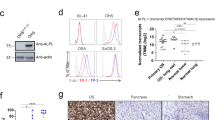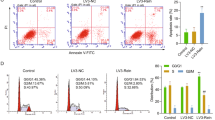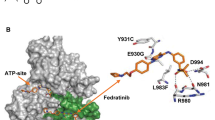Abstract
Given the prevalence of osteolytic bone disease in multiple myeloma (MM), novel therapies targeting bone microenvironment are essential. Previous studies have identified activin A to be of critical importance in MM-induced osteolysis. Lenalidomide is a known and approved treatment strategy for relapsed MM. Our findings demonstrate that lenalidomide acts directly on bone marrow stromal cells via an Akt-mediated increase in Jun N-terminal kinase-dependent signaling resulting in activin A secretion, with consequent inhibition of osteoblastogenesis. Here, we attempted to augment the antitumor benefits of lenalidomide while overcoming its effects on osteoblastogenesis by combining it with a neutralizing antibody to activin A. Increased activin A secretion induced by lenalidomide was abrogated by the addition of activin A-neutralizing antibody, which effectively restored osteoblast function and inhibited MM-induced osteolysis without negating the cytotoxic effects of lenalidomide on malignant cells. This provides the rationale for an ongoing clinical trial (NCT01562405) combining lenalidomide with an anti-activin A strategy.
This is a preview of subscription content, access via your institution
Access options
Subscribe to this journal
Receive 12 print issues and online access
$259.00 per year
only $21.58 per issue
Buy this article
- Purchase on Springer Link
- Instant access to full article PDF
Prices may be subject to local taxes which are calculated during checkout





Similar content being viewed by others
References
Raje N, Roodman GD . Advances in the biology and treatment of bone disease in multiple myeloma. Clin Cancer Res 2011; 17: 1278–1286.
Bataille R, Chappard D, Marcelli C, Dessauw P, Sany J, Baldet P et al. Mechanisms of bone destruction in multiple myeloma: the importance of an unbalanced process in determining the severity of lytic bone disease. J Clin Oncol 1989; 7: 1909–1914.
Giuliani N, Rizzoli V, Roodman GD . Multiple myeloma bone disease: pathophysiology of osteoblast inhibition. Blood 2006; 108: 3992–3996.
Vallet S, Palumbo A, Raje N, Boccadoro M, Anderson KC . Thalidomide and lenalidomide: mechanism-based potential drug combinations. Leuk Lymphoma 2008; 49: 1238–1245.
Kotla V, Goel S, Nischal S, Heuck C, Vivek K, Das B et al. Mechanism of action of lenalidomide in hematological malignancies. J Hematol Oncol 2009; 2: 36.
Breitkreutz I, Raab MS, Vallet S, Hideshima T, Raje N, Mitsiades C et al. Lenalidomide inhibits osteoclastogenesis, survival factors and bone-remodeling markers in multiple myeloma. Leukemia 2008; 22: 1925–1932.
Vallet S, Mukherjee S, Vaghela N, Hideshima T, Fulciniti M, Pozzi S et al. Activin A promotes multiple myeloma-induced osteolysis and is a promising target for myeloma bone disease. Proc Natl Acad Sci USA 2010; 107: 5124–5129.
Matsuo Y, Drexler HG, Nishizaki C, Harashima A, Fukuda S, Kozuka T et al. Human bone marrow stroma-dependent cell line MOLP-5 derived from a patient in leukaemic phase of multiple myeloma. Br J Haematol 2000; 109: 54–63.
Santo L, Vallet S, Hideshima T, Cirstea D, Ikeda H, Pozzi S et al. AT7519, A novel small molecule multi-cyclin-dependent kinase inhibitor, induces apoptosis in multiple myeloma via GSK-3beta activation and RNA polymerase II inhibition. Oncogene 2010; 29: 2325–2336.
Pozzi S, Vallet S, Mukherjee S, Cirstea D, Vaghela N, Santo L et al. High-dose zoledronic acid impacts bone remodeling with effects on osteoblastic lineage and bone mechanical properties. Clin Cancer Res 2009; 15: 5829–5839.
Mukherjee S, Raje N, Schoonmaker JA, Liu JC, Hideshima T, Wein MN et al. Pharmacologic targeting of a stem/progenitor population in vivo is associated with enhanced bone regeneration in mice. J Clin Invest 2008; 118: 491–504.
Vallet S, Raje N, Ishitsuka K, Hideshima T, Podar K, Chhetri S et al. MLN3897, a novel CCR1 inhibitor, impairs osteoclastogenesis and inhibits the interaction of multiple myeloma cells and osteoclasts. Blood 2007; 110: 3744–3752.
Raje N, Hideshima T, Mukherjee S, Raab M, Vallet S, Chhetri S et al. Preclinical activity of P276-00, a novel small-molecule cyclin-dependent kinase inhibitor in the therapy of multiple myeloma. Leukemia 2009; 23: 961–970.
Samee N, Geoffroy V, Marty C, Schiltz C, Vieux-Rochas M, Levi G et al. Dlx5, a positive regulator of osteoblastogenesis, is essential for osteoblast-osteoclast coupling. Am J Pathol 2008; 173: 773–780.
Roodman GD . Pathogenesis of myeloma bone disease. J Cell Biochem 2010; 109: 283–291.
Giuliani N, Colla S, Morandi F, Lazzaretti M, Sala R, Bonomini S et al. Myeloma cells block RUNX2/CBFA1 activity in human bone marrow osteoblast progenitors and inhibit osteoblast formation and differentiation. Blood 2005; 106: 2472–2483.
Gupta D, Treon SP, Shima Y, Hideshima T, Podar K, Tai YT et al. Adherence of multiple myeloma cells to bone marrow stromal cells upregulates vascular endothelial growth factor secretion: therapeutic applications. Leukemia 2001; 15: 1950–1961.
Dimopoulos M, Spencer A, Attal M, Prince HM, Harousseau JL, Dmoszynska A et al. Lenalidomide plus dexamethasone for relapsed or refractory multiple myeloma. N Engl J Med 2007; 357: 2123–2132.
Weber DM, Chen C, Niesvizky R, Wang M, Belch A, Stadtmauer EA et al. Lenalidomide plus dexamethasone for relapsed multiple myeloma in North America. N Engl J Med 2007; 357: 2133–2142.
Mitsiades N, Mitsiades CS, Poulaki V, Chauhan D, Richardson PG, Hideshima T et al. Apoptotic signaling induced by immunomodulatory thalidomide analogs in human multiple myeloma cells: therapeutic implications. Blood 2002; 99: 4525–4530.
Hideshima T, Chauhan D, Schlossman R, Richardson P, Anderson KC . The role of tumor necrosis factor alpha in the pathophysiology of human multiple myeloma: therapeutic applications. Oncogene 2001; 20: 4519–4527.
Munemasa S, Sakai A, Kuroda Y, Okikawa Y, Katayama Y, Asaoku H et al. Osteoprogenitor differentiation is not affected by immunomodulatory thalidomide analogs but is promoted by low bortezomib concentration, while both agents suppress osteoclast differentiation. Int J Oncol 2008; 33: 129–136.
De Matteo M, Brunetti AE, Maiorano E, Cafforio P, Dammacco F, Silvestris F . Constitutive down-regulation of Osterix in osteoblasts from myeloma patients: in vitro effect of Bortezomib and Lenalidomide. Leuk Res 2010; 34: 243–249.
Terpos E, Dimopoulos MA, Sezer O . The effect of novel anti-myeloma agents on bone metabolism of patients with multiple myeloma. Leukemia 2007; 21: 1875–1884.
Ikenoue T, Jingushi S, Urabe K, Okazaki K, Iwamoto Y . Inhibitory effects of activin-A on osteoblast differentiation during cultures of fetal rat calvarial cells. J Cell Biochem 1999; 75: 206–214.
Eijken M, Swagemakers S, Koedam M, Steenbergen C, Derkx P, Uitterlinden AG et al. The activin A-follistatin system: potent regulator of human extracellular matrix mineralization. FASEB J 2007; 21: 2949–2960.
Tanimoto K, Yoshida E, Mita S, Nibu Y, Murakami K, Fukamizu A . Human activin betaA gene. Identification of novel 5′ exon, functional promoter, and enhancers. J Biol Chem 1996; 271: 32760–32769.
Holleville N, Quilhac A, Bontoux M, Monsoro-Burq AH . BMP signals regulate Dlx5 during early avian skull development. Dev Biol 2003; 257: 177–189.
Lee MH, Kim YJ, Kim HJ, Park HD, Kang AR, Kyung HM et al. BMP-2-induced Runx2 expression is mediated by Dlx5, and TGF-beta 1 opposes the BMP-2-induced osteoblast differentiation by suppression of Dlx5 expression. J Biol Chem 2003; 278: 34387–34394.
Clements M, Pernaute B, Vella F, Rodriguez TA . Crosstalk between Nodal/activin and MAPK p38 signaling is essential for anterior-posterior axis specification. Curr Biol 2011; 21: 1289–1295.
Raje N, Vallet S . Sotatercept, a soluble activin receptor type 2A IgG-Fc fusion protein for the treatment of anemia and bone loss. Curr Opin Mol Ther 2010; 12: 586–597.
Mulivor AW, Barbosa D, Kumar R, Pearsall AE, Underwood KW, Ucran JA et al. RAP-011, a soluble activin receptor type IIA IgG-Fc-fusion protein, is a novel bone anabolic agent that prevents bone loss in a mouse model of metastatic breast cancer. Bone 2008; 44 (Supplement 2): S221–S222.
Pearsall RS, Canalis E, Cornwall-Brady M, Underwood KW, Haigis B, Ucran J et al. A soluble activin type IIA receptor induces bone formation and improves skeletal integrity. Proc Natl Acad Sci USA 2008; 105: 7082–7087.
Shao L, Frigon NL, Young AL, Yu AL, Mathews LS, Vaughan J et al. Effect of activin A on globin gene expression in purified human erythroid progenitors. Blood 1992; 79: 773–781.
Shiozaki M, Sakai R, Tabuchi M, Nakamura T, Sugino K, Sugino H et al. Evidence for the participation of endogenous activin A/erythroid differentiation factor in the regulation of erythropoiesis. Proc Natl Acad Sci USA 1992; 89: 1553–1556.
Ruckle J, Jacobs M, Kramer W, Pearsall AE, Kumar R, Underwood KW et al. Single-dose, randomized, double-blind, placebo-controlled study of ACE-011 (ActRIIA-IgG1) in postmenopausal women. J Bone Miner Res 2009; 24: 744–752.
Richardson PG, Blood E, Mitsiades CS, Jagannath S, Zeldenrust SR, Alsina M et al. A randomized phase 2 study of lenalidomide therapy for patients with relapsed or relapsed and refractory multiple myeloma. Blood 2006; 108: 3458–3464.
Richardson P, Jagannath S, Hussein M, Berenson J, Singhal S, Irwin D et al. Safety and efficacy of single-agent lenalidomide in patients with relapsed and refractory multiple myeloma. Blood 2009; 114: 772–778.
Abdulkadyrov KM, Salogub GN, Khuazheva NK, Woolf R, Haltom E, Borgstein NG et al. ACE-011, a soluble activin receptor type Iia IgG-Fc fusion protein, increases hemoglobin (Hb) and improves bone lesions in multiple myeloma patients receiving myelosuppressive chemotherapy: preliminary analysis,. Blood 2009; 114, 749 abstract.
Acknowledgements
NR is supported by LLS and MMRF.
Author Contributions
TS designed research, performed experiments, collected data, analyzed and interpreted data, wrote the manuscript, LS and SV designed research, performed experiments, collected data, analyzed and interpreted data, KP performed experiments, collected and analyzed data, MF, HE, DC, AY, AM carried out research and collected data, NR designed research, provided the environment and support, and wrote the manuscript.
Author information
Authors and Affiliations
Corresponding author
Ethics declarations
Competing interests
NR is on the advisory board of Celgene, Novartis, Millenium, Onyx and Amgen. NR has research funding from Acetylon Pharmaceuticals Inc. and Eli Lilly. The remaining authors declare no conflict of interest.
Additional information
Supplementary Information accompanies this paper on the Leukemia website
Supplementary information
Rights and permissions
About this article
Cite this article
Scullen, T., Santo, L., Vallet, S. et al. Lenalidomide in combination with an activin A-neutralizing antibody: preclinical rationale for a novel anti-myeloma strategy. Leukemia 27, 1715–1721 (2013). https://doi.org/10.1038/leu.2013.50
Received:
Revised:
Accepted:
Published:
Issue Date:
DOI: https://doi.org/10.1038/leu.2013.50
Keywords
This article is cited by
-
Role of stromal activin A in human pancreatic cancer and metastasis in mice
Scientific Reports (2021)
-
Transforming growth factor (TGF)-β pathway as a therapeutic target in lower risk myelodysplastic syndromes
Leukemia (2019)
-
Pathogenesis of bone disease in multiple myeloma: from bench to bedside
Blood Cancer Journal (2018)
-
Bone-Targeted Therapies in Cancer-Induced Bone Disease
Calcified Tissue International (2018)
-
Myeloma and Bone Disease
Current Osteoporosis Reports (2017)



